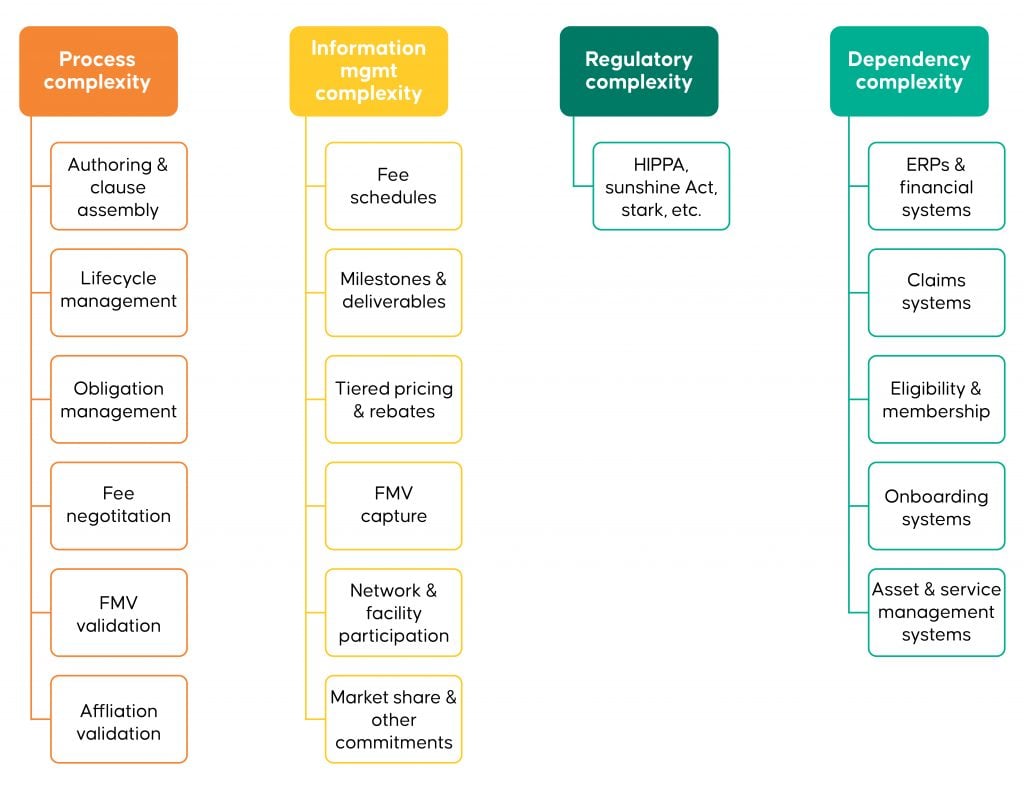Note: This article provides a glimpse into managing existing complexities across healthcare and life sciences contracts. If you want to know more on contract management complexities and how to manage them with confidence, watch this on-demand webinar.

Recently for Healthcare & Life Sciences (HLS), we discussed the most critical and common intricacies in contract management like how to proactively manage obligations, which risk factors to look at, and more.
So let’s start first with the common complexities you should look at while evaluating contracts & vendor agreements. We’ve divided the complexities into four categories –
- By Process
- By Regulations
- By Information Management
- By Dependency
Healthcare and life sciences contract management complexities

[A] Process complexity
Contract authoring and clause assembly

Fueled by technology, contract authoring has matured from writing contracts to assembling contracts. Clause management is an essential driver for optimization within the contract authoring process. These clauses are usually created and reviewed by a legal team. Clauses in most organizations grow organically and reside in multiple places, and in most cases, within numerous versions of templates.
Contract lifecycle and managing obligations associated with it

Most healthcare organizations rely on spreadsheets, fragmented file storage, and email to manage contracts. Manual contract management not only delays contract cycles down but also results in overlooked requests, unpredictable turnaround times, missed key dates and milestones for contract renewals, expirations, and terminations.
Another major pitfall of manual contract management is the lack of standardization of required terms, contract templates, and legal changes that cause revenue leakage.
Here comes a dire need for disciplined obligation management to prevent revenue leakage and accelerate contract compliance. Obligation management is essential not only to understand contract obligations but also to mitigate risks and avoid penalties associated with non-compliance.
Fee negotiation

Most respondents to the latest Value-Based Care Assessment from Insights said over 75 percent of their organization’s revenue is from fee-for-service contracts. However, fee-for-service contracts present a real challenge to value-based care, especially for physician practices.
Negotiation is the process by which two or more parties with different interests or perspectives attempt to reach an agreement.
For example, issues often crop up in healthcare fees for service, pay for performance, and bundled payments models due to a lack of common acceptance of terms and conditions. Physicians need good contracts to survive in practice today. Whether they are contracts with payers or employment contracts, many physicians do not negotiate the way they should or sometimes even know what’s negotiable and what’s not.
FMV validation

With advanced prosecution targeting Medical Device, Pharmaceutical, and Biotechnology companies under the Anti-Kickback Statute and the False Claims Act, formal assessments of “bona fide service” and “fair market value” can be a critical step in verifying the appropriateness of payments by manufacturers to various constituents in the healthcare supply chain.
Top of that, one company’s fair market value may not represent fair market value for another. Hence, a customized approach is generally developed to meet the specific valuation need.
[B] Regulatory complexity
Regulations are varied and complex. Further, legacy systems and manual processes are insufficient to handle the volume and velocity of care delivery. Healthcare and Life Sciences organizations are subject to numerous laws, such as HIPAA, Stark laws, and the Sunshine Act.

Agreements across the industry include obligations tied to statutes, but identifying and managing them and keeping up with regulatory changes and compliance risk is challenging and expensive.
[C] Information Management Complexity
Tiered pricing and rebates
Healthcare reform and industry trends are driving pharmaceutical (pharma) companies to reevaluate value-based care strategies. The move to bundled payments, accountable care, comparative effectiveness research (CER), evidence-based medicine (EBM), and payments linked to performance are the direct result of regulatory and market pressures to reduce health costs without compromising safety and quality.

The most prominent challenge is achieving an optimal value-based tiered price that maximizes social welfare must fulfill two objectives:
- Static efficiency, i.e., optimal use of existing products, and
- Dynamic efficiency, i.e., optimal investment in R&D
[D] Dependency Complexity
Asset and service management systems
Do you know that around 45% of hospitals believe they do not manage their medical assets properly?
Asset management has always presented a unique set of challenges for large organizations. For example, healthcare is experiencing an influx of new asset classes every day and a growing variety!

According to the WHO, even hospitals with precise operational needs and only a handful of complicated assets need effective healthcare asset management – there is no alternative!
Despite being an integral part of healthcare IT asset management systems, the hospital industry lags behind other sectors when it comes to using the right technology to track and manage their assets. This leads to the overutilization or under-utilization of their inventory assets.
Claims systems
To ensure that claims are paid on time, healthcare provider organizations must first comprehend how the different elements of claims management affect reimbursement. Ensuring correct reimbursement on time is always at the top of a healthcare provider’s mind. However, many provider organizations could be leaving money on the table with inadequate and inefficient payer contract management.
The above-given pointers are not the exhaustive list. Many areas of the industry are facing challenges and complexities, which may be handled better with efficient contracting in place.
What Next?
Are your contracting processes prepared to handle healthcare industry agility demands?
Attend this on-demand webinar to learn how to overcome existing barriers and drive efficiency and regulatory compliance by transforming contract and obligation management using AI and modern digital workflows.



